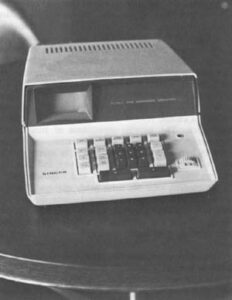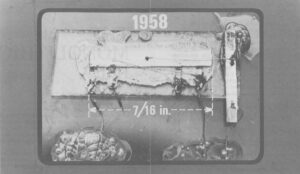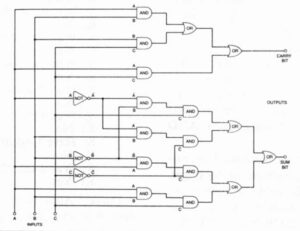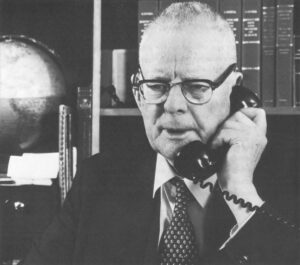One fine day in 1970, an architect named Paul Hemphill counted out $200 as a down payment, signed a finance contract covering the remainder of the $1,500 purchase price, and walked out of his dealer’s showroom as the proud owner of a sleek new automatic that had won his heart because of its speed, ease of handling, and advanced design.
How much would he pay for an equivalent model today?
If it had been a car that Hemphill bought a dozen years ago, he could expect to pay at least $6,000 for a roughly similar model now. If his 1970 purchase had been, say, a typewriter, a major appliance, or almost any other such product, he would probably pay about 2 1/2 times as much in 1982; the consumer price index for durable goods has risen about 150 percent in the last 12 years. In fact, though, what Paul Hemphill bought in 1970 was a four-function (add, subtract, multiply, divide) electronic calculator. If he chose today to buy a model roughly equivalent to the $1,500 machine he got in 1970, the purchase would set him back about $9.95. And his 1982 calculator would be smaller, lighter, faster, and far more energy efficient than the machine he bought a dozen years before.
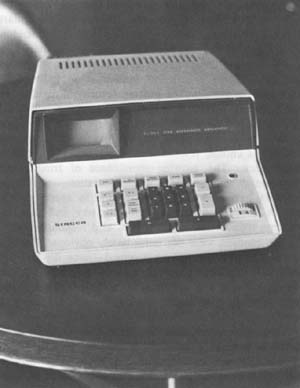
In an era when inexorable inflation has driven the price of almost all goods and services up, up, and up again, such dramatic deflation could almost be a fantasy. But it’s a fact–as any recent calculator buyer can witness–and there’s a straightforward factual explanation for it. About the time Paul Hemphill invested in his $1,500 calculator, the American semiconductor industry–those ingenious people who created the integrated circuit, in which thousands of electronic components can be jammed onto a silicon chip the size of an infant’s thumbnail–had gotten interested in calculators.
In 1971, the first electronic calculators built around a single semiconductor chip were introduced. The price of a simple four-function calculator–a device known in the industry as “plain vanilla”–dropped to $200; it has been dropping further ever since. And manufacturers have not restricted themselves to vanilla. There are nearly 200 different models of hand-held calculators on the market right now, and much of the competition today consists of dreaming up a more exotic gimmick than anyone else. The best selling new item in the field is a Japanese-made Casio calculator that comes attached to an electronic musical keyboard–”the first piano in history that can compute a square root,” Casio boasts. Texas Instruments, the leading American maker, is fighting back with machines that talk to you–”with a warm, synthesized voice,” the company’s catalogue promises.
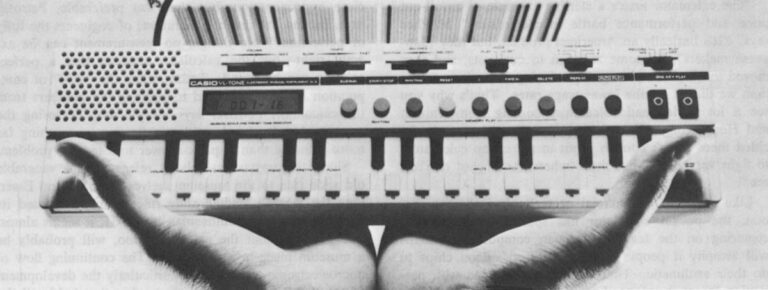
The pocket calculator’s fantastic history is standard stuff for the semiconductor industry. Since the invention of the integrated circuit–the device popularly known as the “semiconductor chip”–24 years ago, the combination of accelerating technology and aggressive competition in semiconductors has meant steadily increasing capacity coupled with steadily decreasing prices. The first commercial semiconductor chips contained about a dozen electronic components and sold for more than $100–roughly $10 per component. Today’s chips routinely hold tens of thousands of components, and prices, according to a Commerce Department study, average less than $0.001 per component.
It is not just in price, though, that the pocket calculator reflects the industry that produced it. To study the history of the small calculator is to study, in microcosm, the history of the American semiconductor industry.
History of the Pocket Calculator
The hand-held calculator, like almost every other important advance in semiconductor electronics, was the result of carefully directed technological study; the man who invented the first hand-held calculator did so because his boss told him to. Though the creative spark and the first important steps in the calculator’s history were American, U.S. manufacturers gradually lost the edge–as they have in several other important semiconductor products–to the Japanese. Japanese firms dominate world calculator market today, and even in this country, the Commerce Department says, about 70 percent of the calculators purchased each year come from across the Pacific. Patriotic Americans need not despair too much, though, for the calculator–and this, too, is typical of the industry–is about to be swamped by a new technological wave. A new product, based mainly on American ingenuity, is moving into the market. By the end of the 1980’s or so, the hand-held calculator can be expected to go the way of the 78 RPM record and the glass milk bottle.
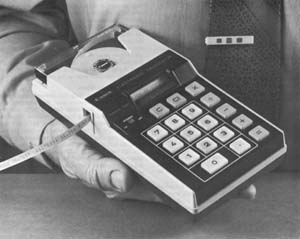
The history of the pocket calculator also illustrates how pervasive the new microelectronic technology has become–particularly among Americans, who seem less frightened of high-tech advances than people elsewhere. Within a decade after the first pocket calculator was sold in the United States, according to industry figures, the country had more calculators than people. Despite dire predictions from some educators that calculators will undermine basic math skills, the small calculator has become a standard item in the school child’s book bag. “Have you noticed,” observed the psychologist Christopher Evans, “how pocket calculators have swept through the school system while teachers and educational authorities are still arguing whether they should be banned?”
Machines that can perform mathematical calculations have been around since the 17th century, when two math pioneers, Blaise Pascal and Gottfried Leibnitz, separately worked out an adding machine based on a series of connected gears with nine teeth each. To add 5+3, you dialed the first gear through five revolutions, and then through three more; the tooth numbered “8” would then be on top, and there was your answer. Behind the ninth tooth on each gear was a trip lever that would pass the rotation to another gear; in that way, the device could borrow and carry. With improvements, this “Pascaline” arrangement survived more than three centuries. It was the heart of all adding machines and calculators through the 1950’s.
Then microelectronics began to move in. With the invention of the transistor, in 1947, and the integrated circuit, in 1958, the nine-toothed gears gave way to electronic devices that translated decimal numbers into binary mathematics–in which any number can be represented by combinations of “on” or “off” electronic signals. Calculations were performed not by turning gears but by digital logic techniques that manipulated the “on” and “off” pulses.
This made for faster, quieter, and more reliable operation–in electronic devices, the only “moving parts” are electric charges zipping silently through the circuit at the speed of light–but in the beginning there were no noticeable reductions in size or cost. The standard model that Paul Hemphill bought was as big and as heavy as an office typewriter.
Some of the major innovations of latter-day technology have come from basic academic research–the laser, for example–with no clear application in mind. Some others–teflon, for example–have come about more or less by accident. In microelectronics, though, almost all the major advances have come about because someone was trying to hit a specific target. The pocket calculator fits that pattern precisely.
The push to produce a smaller, cheaper calculator came mainly from Texas Instruments. The idea stemmed from an earlier marketing ploy that had paid off richly. In 1954, when the transistor was still a mysterious piece of black magic to most people, Texas Instruments decided to put transistors into a common consumer product. The result was the transistor radio, one of the most successful new consumer products in industrial history. Ten years later, Texas Instruments’ president, Patrick Haggerty, decided to repeat that gambit in order to spread public awareness of the integrated circuit. He started looking for a product that would put the chip into every home. One day late in 1964, Haggerty called in one of his engineers and told him to invent a calculator that would fit in a pocket and cost about $100.
It was a formidable assignment, but Haggerty gave it to a formidable engineer: Jack St. Clair Kilby, a tall, thoughtful, soft-spoken Kansan who was a co-inventor of the integrated circuit itself. Working with two other Texas Instruments engineers, James Van Tassel and Jerry Merryman, Kilby moved section by section through one of the advanced electronic calculators of the day, cutting size and cost and weight wherever he could. Kilby’s team managed to squeeze all the computational and logic circuitry a calculator needed onto four chips, each the size of a match head (further work quickly reduced the whole works to a single chip). They drastically simplified the circuits carrying information from the keyboard to the computational chip, and they came up with a totally new way to print and display the answer. Kilby had the job done on paper by 1967, and filed his patent application that year. But the design was so far beyond the state of engineering art that it was not until 1971 that the pocket calculator went on the market.
80 Million Calculators
You would need a fairly high-powered calculator to keep track of what happened next. Five million calculators were sold in the United States in 1972. As new features were added and prices dropped–a “plain vanilla” model cost $100 by the end of 1972, $25 four years later, and $15 two years after that–sales doubled year after year. By 1980, with plain vanilla near the $10 mark, the U.S. market was virtually saturated; yet Americans still buy between 26 million and 30 million replacement calculators every year. Manufacturers still have the rest of the world to shoot at, of course; industry analysts predict worldwide sales of 80 million calculators this year. In 1980, the latest year for which full data are available, global calculator sales topped the billion-dollar level.
Within a decade of its birth–unusually soon for a major consumer product–the calculator reached what retailing experts call the “mature end” of the product cycle. Among other things, that means that the market is broken into clearly segmented categories–four of them in the calculator’s case. At the high-priced end, where prices still exceed $125, are the programmable calculators, which fit somewhere along the always fuzzy line between calculators and computers. In between, at prices ranging from $30 to $130–are the scientific, or “slide rule” calculators (which can handle much of the sophisticated math involved in science and engineering) and business calculators that provide a printed data trail of computations. The most interesting facet of today’s market is the bottom, where makers compete in sheer ingenuity to spice up the plain vanilla calculator and thus win the favor of consumers.
If you wanted to buy a simple four-function calculator tomorrow, you would have your choice of denim-clad calculators, designer-label calculators, wrist-watch-sized calculators, ring-sized calculators, or calculators built into pianos, pendants, and fountain pens. You could pay anywhere from $9.95 for basic black at K-mart to $7,500 for a 24-karat gold version at Pierre Cardin.
There is a bewildering and ever-changing variety of specialized models, including:
Calculators that tell your fortune, read your star chart, and track your biorhythms.
Calculators that handicap horse races and compute the odds after each new deal in Blackjack.
Calculators that take a taxpayer step-by-step through form 1040.
Clip-to-the-belt calculators that keep track of calorie intake while you eat and calorie consumption while you exercise.
Calculators that convert dollars to yen (or pounds, or rubles), miles to kilometers (or yards, or centimeters), and English to French (or German, or Japanese).
Calculators that let you conduct a boxing match, compose a song, or conquer an electronic Rubik’s Cube on the screen if you get bored between calculations.
Calculators designed specifically for accountants, auto mechanics, securities analysts, real estate brokers, pilots, navigators, farmers, and–naturally–computer programmers.
Much of the ingenuity, and most of the business, in the calculator market these days belongs to the Japanese–particularly to two firms, Casio and Sharp (Matsushita), which have become the world leaders in sales of this American invention.
American and Japanese manufacturers have been playing nip-and-tuck in the calculator trade for two decades now. Through the 1950’s, when calculating machines still involved toothed-gear mechanisms, American firms dominated the world. But the Japanese came on strong in the ’60’s, when U.S. adding-machine makers were slow to move into the uncertain new world of electronics. By the time Paul Hemphill bought his machine in 1970, according to a Commerce Department study, Japanese calculators were outselling American brands in the U.S. and around the world. The advent of the single-chip calculator reversed things; within three years after Texas Instruments perfected the hand-held calculator, U.S. makers had regained their traditional lead. But the Japanese fought back. They regained dominance in both U.S. and world markets by the end of the ’70’s, and have been increasing their lead since.
How did it happen? Texas Instruments, for one, says Japan infringed its patents. The issue remains to be litigated, but there is evidence to support this view. That alone would not explain the Japanese success, however, according to John McPhee, a business analyst who follows the industry for the Commerce Department. He says the Japanese brought to calculators the same attributes–quality workmanship, aggressive price competition, and marketing ingenuity–that have helped them forge ahead of U.S. firms on some other important semiconductor products.
“The calculator area’s a sterling example of an all-out price and performance battle in electronics,” McPhee says. “It’s basically an American product, but they [Japanese makers] did some redesign to cut costs, and they moved to off-shore [foreign] producing operations earlier than we did to get the lower wage rates. That’s why you see a lot of low-end calculators coming from Taiwan and Hong Kong. A lot of the American firms just decided there wasn’t enough profit in the cheap calculators to fight very hard–but that’s where the biggest markets are.”
Like any new commercial or technological phenomenon, the pocket calculator has sparked controversy–centering on the fear that human computational skills will atrophy if people come to rely on silicon chips to do their arithmetic. The concern is expressed with particular fervor by John Lewis, a British educator who warns that “numeracy”–mastering basic math skills–is as important to society as literacy. “If the present trend of calculator usage continues,” Lewis says, schools will turn out “a breed of innumerate children.”
I can personally attest that there is some basis for this fear. Speaking recently to a 6th grade math class in a top-ranking private school, I asked the kids to determine how much ten percent of one million would be. The whole class pulled out pocket calculators–for a problem that earlier generations could solve almost instantly in their heads.
On the other hand, some educators call for greater use of calculators in the classroom. Professor Bruce R. Vogeli of Columbia University argues that using a calculator for long arithmetical computations can overcome the “math anxiety” that scares many students away from all mathematics. “Someday,” Vogeli says, “long divisions will be taught just the way Roman numerals are today–as historical artifacts, interesting but not very useful.” Freed from the time and tedium involved in long division or other calculations, Vogeli says, calculator-equipped students can concentrate on “applying mathematics to real problems.”
On yet another hand, many science and engineering teachers lament the disappearance of the slide rule, a traditional tool of technology that met its demise when the pocket calculator–cheaper, faster, easier to use, and more accurate–came along. No slide rule could approach the pinpoint eight-digit accuracy that any calculator can provide, and no slide rule could place the decimal point at the right spot in the answer, as calculators do automatically. But according to Prof. Henry Petroski, of the engineering faculty at Duke University, “the limitations of the slide rule were also its strengths.”
“The absence of a decimal point meant that an engineer always had to make a quick mental calculation independent of the calculating instrument,” Petroski says, and that taught “an intuitive appreciation of magnitudes.” The answer from a slide rule was rarely more than a close approximation; but that was preferable, Petroski says, because it “taught generations of engineers the folly of perfection.” No design, no measurement can be exactly right–but the calculator suggests that a perfect solution can be found. Today, when the “skill” of computation has been reduced to copying the numbers from the calculator, Petroski says, people may be losing the associated skill of independent reflection–something far more valuable than a quick answer to a tedious problem.
Since the upstart calculator relegated the venerable old slide rule to the museum shelves (Keuffel and Esser, long the world’s leading slide rule maker, presented its final model to the Smithsonian in 1976), it seems almost poetic justice that the calculator, too, will probably be a museum piece in a few years. The continuing flow of microelectronic technology–particularly the development of the “microprocessor,” a single chip that holds all the circuitry of a computer–has made possible a new upstart: the pocket computer.
Things change so fast in the semiconductor business that labels are not always precise. There has never been a clear line of demarcation between the “calculator” and the “computer.” Basically, though, there are two distinctions. First, a computer can work with words as well as numbers, whereas verbal information usually requires more memory capability than a calculator can provide. More important, a computer can be programmed by the user to do whatever the user wants; a calculator can perform only the specific tasks programmed in at the factory. The difference is akin to that between a passenger train and an automobile. The railroad passenger, like the calculator buyer, can go only where the company’s tracks lead; a driver can take his automobile–or his computer–anywhere he wants to go.
Advances in logic design and memory capacities made the pocket computer a reality–at $300 or more–about three years ago. Prices have dropped rapidly, of course. This fall the first $99.95 pocket computer will hit the market, and within five years prices are likely to be competitive with most pocket calculators.
“People are already moving to the pocket calculator, and it has to increase,” says Bennett Sanders, Casio’s U.S. marketing manager. “You get all that power in your pocket for about the same price…I think that by the end of this decade, every household will have a little computer. It’s the pocket calculator coming at you all over again.”
©1982 T. R. Reid
T. R. Reid, national reporter on leave from the Washington Post, is investigating the U.S. semiconductor industry.

